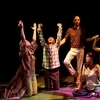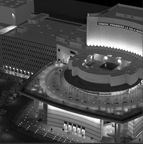News
The reconstruction of the ”I.L.Caragiale” National Theatre is nearing completion.
Ion Caramitru, Director-General of the I.L. Caragiale National Theatre of Bucharest, participated in a ribbon-cutting ceremony marking the opening of the NTB building, along with Prime Minister (and Interim Minister of Culture) Victor Ponta. Also present at the event were former Prime Minister Calin Popescu-Tariceanu and former Minister of Finance Sebastian Vladescu, who contracted the loan for the renovation of the instituion during their mandate, and former Minister of Culture, Kelemen Hunor.
The event - which was organised under the auspices of the Prime Minister’s Office and the Ministry of Culture – was highly publicized by the written and audiovisual media, which transmitted detalied reports from the scene.
We remind that the I.L. Caragiale National Theatre of Bucharest has been the subject of extensive rehabilitation and restauration works (started in 2011), which are coming to an end: the reception is due the 30th of November 2014, after which the constructor has three more months at his disposal for the finishing touches of the project. The stage of the Great Hall will become functional only after all the technical mechanisms have been rigorously tested.
We reproduce here the full statement of Ion Caramitru, given on the 10th of November 2014:
[...The building dates from...] Gheorghiu-Dej’s time and it was inaugurated in 1973. For those of you who may not know, before the construction of the theatre, on this location stood the Krately Circus. Construction began jointly with the underground parking and the InterContinental Hotel. Thus, all the utilities were shared, which was initially a problem for the reconstruction, one which we managed to overcome. After that, as you probably know, there was the 1977 earthquake which the building, as you see it, survived unharmed, then, in 1978, a great fire destroyed the Great Hall.
Once the reconstruction of the Great Hall began, the building was modified at the order of Nicolae Ceausescu. The Great Hall was extended – Ceausescu wanted 1500 seats, but only 1200 were possible, so another hall was built bellow it, the Amphitheatre Hall, with a capacity of 300 seats, but which no longer exists, as it lacked the specific utilities for the functioning of the stage. In addition, they built that now-infamous presidential lodge and the hall had to be extended and heightened. For this purpose, the lateral seismic resistance systems were eliminated, more precisely, four 80-centimetres-wide diaphragms, which meant that the hall lost its acoustic, its intelligibility and in fact its visibility. (What you will see now is the full return to the original design of the Great Hall). Then, there was also the addition of the facade (which we cannot see in the present, it was the first to be demolished) weighing 1400 tons, out of which 70 per cent rested on the undergroung parking (therefore on thin, fragile ground).
This means that the main reason for the investment in this objective was the need for seisimic consolidation. The two important expertises, one which took place before my arrival here and one after 2005, a counter-expertise, clearly showed that in the event of a 6.5-degree earthquake, the entire building would have collapsed, buried in the parking. At this moment, you are in perfect safety, as the reconstructed building has a resistance for an 8-degree earthquake on the Richter scale, which has never happened before and hopefully will never happen.
Aside from the reconstruction, what is personally significant for me is the fact that the first demolition of a communist edifice happened here. The North Korean facade ordered and brought by Ceausescu has disappeared, and the beauty of the building has returned to the formula you can see now, thanks to our architect, Prof. Dr. Romeo Belea, the artisan and the copyright holder of the project. Everything has been rebuilt, the interior has gained new functions and there are 4 new halls. The theatre will have in total 7 halls, one of them on top of the building (on the roof), functioning during the summer, and one which, for several months, has been at the exclusive use of the young experiment in the Romanian theatre. More exactly, the Small Hall is at the disposal of young, unemployed artists who put forward projects – until now, there have been four premieres, as part of the 9G programme: the National Theatre for the New Generation of artists.
I wish to thank all those who have contributed with their political will and with the necessary fonds. These important works or restoration and recovery representing historical monuments, or presenting national importance, such as the National Library or the National Theatre, were initiated during the Tariceanu government at the idea of the then-Minister of Finances, Sebastian Vladescu. They obtained a loan in very favourable conditions, amounting to one quarter of a billion euros, dedicated exclusively for culture. For those of you who do not know, the money was invested in the National Library, Bucharest National Theatre, Iasi National Theatre, Iasi Palace of Culture and other cultural sites. Of course, the rigorous conditions of such a loan engage the government to participate in parity with budgetary funds. This project has undergone five successive governments, each of whom has been open to it. Therefore, here we are now, in the National Theatre’s most beautiful period of existence, a blissful moment for myself, my colleagues and the Theatre’s admirers, who are glad to finally enter this building.
I would like to thank Mr. Prime Minister Ponta for paying special attention to this site. It is his fourth visit on the site, he has been a witness to all the successive steps, he was won over by the beauty of this project and helped us, and will help us further. Thank you to all those who contributed to the project, the participating governments, including those from the Ministry of Finance, who initially showed a strong resistance to the investments, but who were eventually convinced, so that we can finally take part in this beautiful anniversary moment!
Many thanks to the press for being with us and, through you, to the public and the Romanian citizens, who will soon be able to see what you have seen today.



















